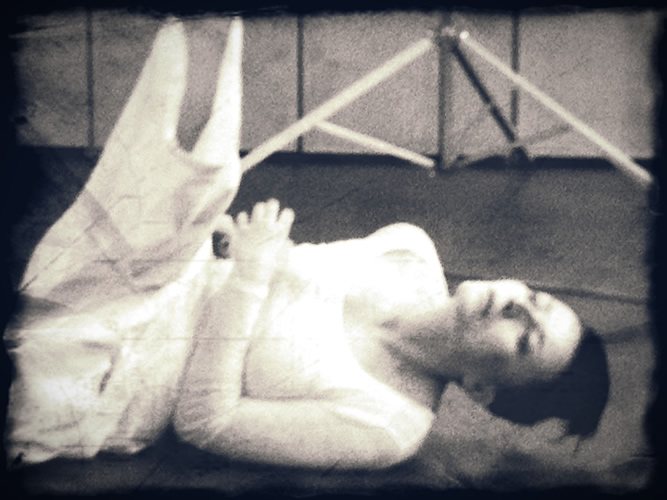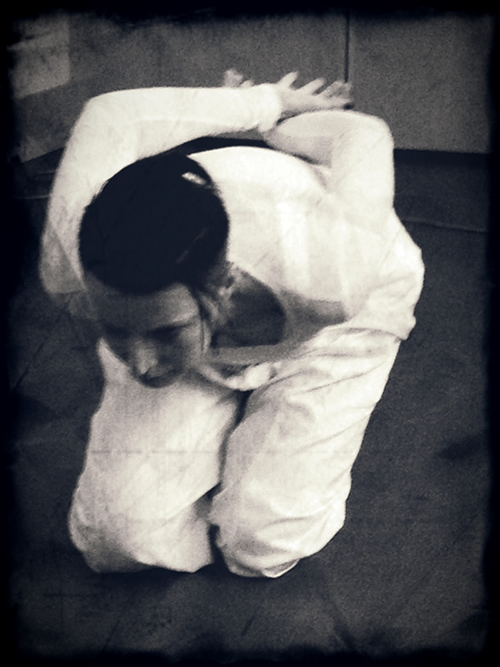I
Oneiroid.
Memory. Forgotten through death. Love.
Unsettled.
You
Live this half-life with me.
Watch me.
Bear burden with me.
I
Sleep. Life. Interrupted.
Disembodied.
Flesh. Digital Memory.
You
Know.
You don’t want to know that you know.
You don’t know.
I
Know.
I refuse to fully assume the consequences of this knowledge.
I can continue acting as if I don’t know.
You
Choice.
Responsibility.
Revealed back to you.
I
Radical vulnerability.
Excavate.
Uncanny. Return.

Oneiroid Askésis
The ethical question of whether or not to do violence emerges only in relation to the ‘you’ who figures as the potential object of my injury. But if there is no ‘you,’ or the ‘you’ cannot be heard or seen, then there is no ethical relation.Oneiroid Askésis is my effort to choreograph violence in relationship to the ethics of photography. Choreographing violence relies on signifying a politically and ideologically coded absence, and the perpetual failure of the sign — memory beyond representation. Central to this project is the institutionally framed, politically charged ethico-aesthetic subjectivity dislocated in an incessant fog of oneiroid tension; tension between semantic openness and structure — space for ethical and political engagement of violence. To this end, Oneiroid Askésis highlights visual juxtapositions (symbolic/convulsive/body/politik) and oneiric closures (memory/evacuation/dream aesthetic) that mediate and intervene in an ethico-aesthetic rearticulation of subjectivity. Choked with Phone Calls From The Dead [2] the aesthetic space of Oneiroid Askésis seizes the dubious creative potentiality of “deterritorialised machinic paths to engender mutant subjectivities.”[3] Therein exists aesthetHic (hic, hic, hiccuping and stammering) subjectivity un/folded within an oneiroid performative, surviving her own death, confronting her right [4] to have rights, problematizing familiar arguments orbiting discursive normalization of violence. Oneiroid Askésis is a medium of interrogation aimed at violence, subjectivity, memory, ethics, and responsibility. More specifically, it considers the visual framings of violence in relationship to:
—Judith Butler[1]
1) politico-ideological representations of ethical/abstract violence;
2) fetishist disavowal [5] of its accumulated atrocity.
Today abstract violence is at its purest in the moment of its hermeneutical renunciation of the very politics that govern it. The persistence of traumatic violence, social conflicts, and new modalities of global capitalism is as anonymous as natural catastrophes. It is devoid of meaning and deprived of the memory of political contestations. Like a Hegelian infinite judgment positing a heterogeneous mixture of nature and politics, anonymous violence is at its strongest when “politics cancels itself as such and takes on the appearance of nature, and nature disappears in order to assume the mask of politics.”[6]
 Oneiroid Askésis embodies reflexive speculations of such anonymous violence that seems to appear out of nowhere in its symbolic, abstract, and invisible ideology. It is precisely these modalities of violence that produce visual experiences, organize symbolic identifications, and regulate specific subject ontologies. The ontologization of violence is structurally fixed and deterministic, and thus precludes any possibility of ethical commitment to the principle of non-violence and protecting the life of another. In Regarding the Pain of Others, Susan Sontag notes that, “To remember is, more and more, not to recall a story but to be able to call up a picture."[7] Yet it is precisely the pictures of events and certain framings of violence that solicit our complicity in visual and conceptual normalization of subjects/populations as targets of destruction.[8] The frame does not so much reveal reality, but “actively participates in a strategy of containment, selectively producing and enforcing what will count as reality. … It seeks to institute an interdiction on mourning: there is no destruction, and there is no loss.”[9] Oneiroid Askésis testifies to an ethics of photography that seeks to form and manage subjects as targets of violence and destruction. It foregrounds a surrealist aesthetic of abjection as a way of eliciting an ethics of responsibility that supports new subjectivities and attend to the “precariousness of life.”[10]
Oneiroid Askésis embodies reflexive speculations of such anonymous violence that seems to appear out of nowhere in its symbolic, abstract, and invisible ideology. It is precisely these modalities of violence that produce visual experiences, organize symbolic identifications, and regulate specific subject ontologies. The ontologization of violence is structurally fixed and deterministic, and thus precludes any possibility of ethical commitment to the principle of non-violence and protecting the life of another. In Regarding the Pain of Others, Susan Sontag notes that, “To remember is, more and more, not to recall a story but to be able to call up a picture."[7] Yet it is precisely the pictures of events and certain framings of violence that solicit our complicity in visual and conceptual normalization of subjects/populations as targets of destruction.[8] The frame does not so much reveal reality, but “actively participates in a strategy of containment, selectively producing and enforcing what will count as reality. … It seeks to institute an interdiction on mourning: there is no destruction, and there is no loss.”[9] Oneiroid Askésis testifies to an ethics of photography that seeks to form and manage subjects as targets of violence and destruction. It foregrounds a surrealist aesthetic of abjection as a way of eliciting an ethics of responsibility that supports new subjectivities and attend to the “precariousness of life.”[10] When in a given political and cultural context the universal human rights are threatened, as the catastrophic character of colonialism, totalitarianism, and modern war made manifest, a new subject emerges — phantasmic and dislocated in its symbolic identity. It stands as a machinic site for transversality and decentering of ethical violence, a medium for disidentification from the visual normalization of violence, and political subjectification of non/life:
The important thing here is not only the confrontation with a new material of expression, but the constitution of complexes of subjectivation: multiple exchanges between individual-group-machine. These complexes actually offer people diverse possibilities for recomposing their existential corporeality, to get out of their respective impasses and, in a certain way, to resingularise themselves.[11]Oneiroid Askésis embodies a dream aesthetHic of irruption. It highlights aesthetic decentering of subjectivities, the deconstructing of politico-ideological normalization of violence, and the fetishist disavowal of its accumulated atrocities. To perform Oneiroid aesthetHic requires processual entanglement of politics, ethics, ideology, and aesthetics; it requires an ethical commitment to life, and a never-ending contestation of frames that apprehend it.
Video Credits
Directing, editing, choreography, and videography by Naida Zukić
Musical composition, "Phone Calls from the Dead," by Salt Theory (aka Craig Gingrich-Philbrook)
Butoh [durational live performance in front of projection of Oneiroid Askésis]
"Straight legs are engendered by a world dominated by reason. Arched legs are born of a world which cannot be expressed in words." (Tatsumi Hijikata)I enter into my Butoh body, which is enduring, uncanny, and ephemeral in its controlled and stylized movement. The Other in the room bears responsibility for finding the body; the body that resists me, unsettled in the darkness, tearing at semantic emanations. Flashlights, shadows, faces, tension, sensation, turbulence; muscular control in the body revealing back to what is with/out. My contorted body moves painfully slowly, from the beginning of torture to the beginning of death; struggling through and affirming the elasticity of time, stretched in opposite directions, pushed to the edge of the razor-sharp vulnerability.
Face stoic.
Mouth gaged.
Eyes are glass.
Askésis projections are cast onto the body, excavating digital memory of the flesh disembodied, apprehending the violently dehumanized figure spasmodically moving beyond liminality—eliciting an ethic. Responsibility.
Notes
[1] Butler, Judith. Frames of War: When is Life Grievable? (London: Verso, 2010), 181.
[2] Salt Theory (aka Craig Gingrich-Philbrook), "Phone Calls from the Dead."
[3] Guattari, Felix. Chaosmosis: An Ethico-Aesthetic Paradigm (Bloomington: Indiana UP, 1995), 90.
[4] Arendt, Hannah. The Origins of Totalitarianism (New York: Harcourt Inc., 1968).
[5] Slavoj Žižek, Violence: Six Sideways Reflections (New York: Picador, 2008).
[6] Slavoj Žižek, Living in the End Times (London: Verso, 2010), 295.
[7] Sontag, Susan. Regarding the Pain of Others (New York: Farrar, Straus, and Giroux, 2003), 70.
[8] Discursive normalization of violence against Trayvon Martin and Marrissa Alexander are immediate examples that come to mind in the wake of George Zimmerman’s acquittal. Such politically saturated, selective, and normalizing frames of violence, also visually normalize civilian deaths in Gaza, force-feeding and torture of Guantanamo Bay detainees, and images of Abu Ghraib prisoner abuse, to name a few.
[9] Butler, xiii.
[10] Butler, 177.
[11] Guattari, 7.
Naida Zukić is Assistant Professor in the Department of Speech, Communication, and Theatre Arts at BMCC, CUNY Manhattan. Butoh choreography of Oneiroid Askésis was first performed at the National Communication Association annual convention in 2011.


